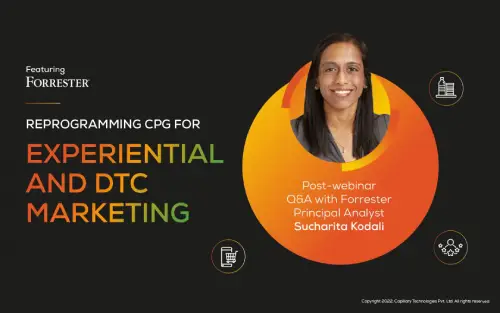- Design industry shaping loyalty programs
- Integrate easily and go live quicker
- Deliver hyper-personalized consumer experiences
Blue Rewards from Al Futtaim Group Shares Loyalty Success Stories and Evolution. Watch Podcast >
Capillary Announces 2nd Annual Captivate 2025 Summit: Transforming Loyalty Management with New AI Tech Read more >

The explosion of data and digitization has curiously made the shopping aisle longer, unlocking several new avenues for CPG brands to innovate with their products and marketing strategies. Most of all, it has opened up gates to a whole new frontier – direct-to-consumer or D2C – an exciting opportunity to sell products directly to consumers and receive access to more customer data.
In our recent webinar on CPG in 2022: Outlook, Trends and Strategies, with guest speakers – Sucharita Kodali (VP, Principal Analyst, Forrester) and Lance Patrick (Global Price and Promotion Analytics Leader, General Mills) along with Justin Richie (Capillary Technologies’ Chief Data Officer), some of CPG’s lesser-known factors that are involved in building D2C strategies are revealed. With D2C becoming an essential route to a brand’s long-term survival, here are 6 features that must be considered while building these digital and data-rich strategies.
The first step to gear up for D2C strategies is ensuring that the entire CPG brand’s organizational structure is aligned to support them. The various teams need to ally to help bring about this revolution in the brand’s roadmap. This includes building a single view of their data, applying the right technology to set up the D2C channel, and ensuring the brand is meticulously publicizing its digital channel directly to its consumers.
As rightly pointed out by Sucharita, “One of the single biggest assets that is essential to driving D2C success, is promoting that you have a website on your existing packaging. If people don’t know that you’re open for sale, who’s going to come to your website?” Eventually, effective collaboration and scalable technology will enable building agility into its strategy.
The typical perspective of a brand is that it doesn’t matter where a sale comes from. On the contrary, once D2C channels are established, it becomes essential to track where sales come from, with D2C becoming more prioritized and profitable. Not only will this channel become a higher margin one, but will help the brand receive direct transactional data that will help understand the biggest brand advocates, their preferences and to test new products with them, leading to a more intimate relationship with customers.
Developing a mobile app may be a good approach to drive engagement, but the brand must ensure a holistic approach before venturing into this digital platform. A brand’s presence across varied social platforms is equally important to leverage this medium by pairing the mobile app with captivating promotions across social media channels. On the other hand, it is also critical for the brand to optimize content for the mobile version of their D2C website, as a majority of the online shopping traffic comes from mobile devices.
While conversion is still lower on mobile compared to desktops, a seamless mobile commerce experience that is strong in every touchpoint can push customers to make purchases within a few clicks. This channel is very well suited for social media promotions, pairing them up with ads that take customers directly to a specific product page.
In the last two years, work, school, leisure, and housing have all evolved, permanently altering the needs and purchase behavior of customers. In this scenario, data plays a major role in helping brands understand the demand patterns and act ahead of time.
Lance Patrick highlighted this need to leverage data as he stated, “No industry is going back to 2019. 2022, 2023 and beyond will be the different phases of the new normal.” He further added that understanding customers can help brands work ahead and adjust to those demands faster. Brands can ‘test and learn’ through data analysis even before they can ‘test and measure’. These consumer hypotheses will enable brands to drive the demand side for your benefit.
Zero-party data or the data that is proactively shared by customers is the most valuable information that can be leveraged to attract a brand’s best customers. While respondents of a survey and focus groups have helped brands historically collect similar data, in the present era, customers are willing to share insights and feedback on products and are looking forward to new products from brands. This gives retailers access to a whole new set of data points that they have not pursued before, empowering them to set a clear roadmap for their products and processes.
To collect this high-value data, structural loyalty can be used as a strategic weapon. While signing up for the loyalty program, customers are agreeing to share their preferences and brands can further incentivize them for deeper insights. This enriched data in turn can help provide personalization to the customer journey.
The large influx of all these sources of data may be daunting, but using smart tools powered by AI and machine learning can help interpret the data and take the next best steps accordingly. “The 2 things that clearly stood out in AI and ML are Segmentation and Personalization,” said Justin Richie, describing that intelligent tools can guide the CPG brand by:
Tune in to our full webinar to learn directly from the experts on how to construct powerful D2C strategies.

March 28, 2022 | 4 Min Read
With more than one-third of consumers continuing to switch b

February 17, 2022 | 4 Min Read
The explosion of data and digitization has curiously made th

February 14, 2018 | 4 Min Read
Indian Consumer Goods/FMCG distribution has always been a dy